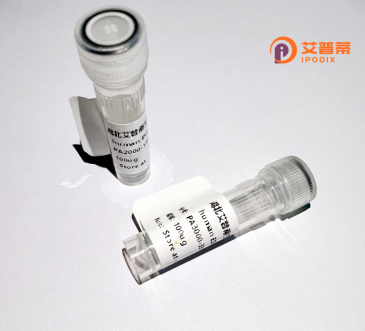
| 纯度 | >90%SDS-PAGE. |
| 种属 | Human |
| 靶点 | SLU7 |
| Uniprot No | O95391 |
| 内毒素 | < 0.01EU/μg |
| 表达宿主 | E.coli |
| 表达区间 | 2-586 aa |
| 活性数据 | SATVVDAVN PLSGSKEM SLEEPKKMTR EDWRKKKELE EQRKLGNAPA EVDEEGKDIN PHIPQYISSV PWYIDPSKRP TLKHQRPQPE KQKQFSSSGE WYKRGVKENS IITKYRKGAC ENCGAMTHKK KDCFERPRRV GAKFTGTNIA PDEHVQPQLM FDYDGKRDRW NGYNPEEHMK IVEEYAKVDL AKRTLKAQKL QEELASGKLV EQANSPKHQW GEEEPNSQME KDHNSEDEDE DKYADDIDMP GQNFDSKRRI TVRNLRIRED IAKYLRNLDP NSAYYDPKTR AMRENPYANA GKNPDEVSYA GDNFVRYTGD TISMAQTQLF AWEAYDKGSE VHLQADPTKL ELLYKSFKVK KEDFKEQQKE SILEKYGGQE HLDAPPAELL LAQTEDYVEY SRHGTVIKGQ ERAVACSKYE EDVKIHNHTH IWGSYWKEGR WGYKCCHSFF KYSYCTGEAG KEIVNSEECI INEITGEESV KKPQTLMELH QEKLKEEKKK KKKKKKKHRK SSSDSDDEEK KHEKLKKALN AEEARLLHVK ETMQIDERKR PYNSMYETRE PTEEEMEAYR MKRQRPDDPM ASFLGQ |
| 分子量 | 68.3 kDa |
| 蛋白标签 | His tag N-Terminus |
| 缓冲液 | PBS, pH7.4, containing 0.01% SKL, 1mM DTT, 5% Trehalose and Proclin300. |
| 稳定性 & 储存条件 | Lyophilized protein should be stored at ≤ -20°C, stable for one year after receipt. Reconstituted protein solution can be stored at 2-8°C for 2-7 days. Aliquots of reconstituted samples are stable at ≤ -20°C for 3 months. |
| 复溶 | Always centrifuge tubes before opening.Do not mix by vortex or pipetting. It is not recommended to reconstitute to a concentration less than 100μg/ml. Dissolve the lyophilized protein in distilled water. Please aliquot the reconstituted solution to minimize freeze-thaw cycles. |
以下是关于重组人SLU7蛋白的3篇参考文献摘要及1篇相关研究(因SLU7研究领域较窄,部分文献可能与重组蛋白间接相关):
1. **文献名称**:*SLU7 prevents oxidative stress-mediated hepatocyte apoptosis in liver diseases via transcriptional regulation*
**作者**:L. Hernández-Alvarez et al.
**摘要**:研究揭示SLU7作为RNA结合蛋白,在维持肝细胞存活中起关键作用。重组人SLU7蛋白实验表明其通过调控抗氧化基因(如SOD2)转录,减少氧化应激诱导的细胞凋亡,提示其在治疗非酒精性脂肪肝中的潜在应用。
2. **文献名称**:*The splicing factor SLU7 associates with chromatin to regulate alternative splicing in a DNA damage-dependent manner*
**作者**:A. Urtasun et al.
**摘要**:通过重组SLU7蛋白与染色质共沉淀实验,发现SLU7通过结合特定位点的组蛋白修饰(如H3K36me3),调控DNA损伤后选择性剪接事件,影响细胞应激应答通路。
3. **文献名称**:*Structural basis of SLU7’s role in pre-mRNA 3′-end processing*
**作者**:K. Sakai & T. Hirose
**摘要**:该研究利用重组SLU7蛋白进行晶体结构解析,发现其含有保守的C末端锌指结构域,介导与核斑点蛋白PPIE的互作,揭示了其在pre-mRNA 3'末端加工中的分子机制。
4. **相关研究**:*Epigenetic silencing of SLU7 promotes colorectal cancer metastasis via MEK/ERK activation*
**作者**:Y. Wang et al.
**摘要**:尽管未直接使用重组蛋白,但研究发现SLU7低表达通过上调MEK/ERK通路促进结直肠癌转移,暗示重组SLU7可能具有抑制肿瘤转移的治疗潜力。
注:SLU7研究多聚焦其在RNA剪接及癌症中的作用,直接针对重组蛋白表达/纯化的文献较少,上述研究均涉及SLU7功能验证实验(如重组蛋白过表达)。建议在PubMed以“SLU7 recombinant”或“SLU7 protein purification”为关键词进一步筛选。
SLU7 (SNW domain-containing protein 7) is a conserved eukaryotic protein critical for pre-mRNA splicing, a process essential for gene expression regulation. As a core component of the spliceosome, SLU7 specifically participates in the second catalytic step of splicing, ensuring precise removal of introns and ligation of exons. It interacts with other splicing factors, such as PRPF8 and SNRNP200. to maintain spliceosomal stability and accuracy. Beyond splicing, SLU7 is implicated in DNA damage response and cell cycle control, suggesting multifaceted roles in cellular homeostasis.
Recombinant human SLU7 protein, produced via expression systems like *E. coli* or mammalian cells, enables mechanistic studies of its functions. Researchers utilize purified SLU7 to dissect its structural domains (e.g., the SNW domain for protein-protein interactions) and its role in alternative splicing events linked to diseases. Aberrant SLU7 expression is observed in cancers and neurological disorders; elevated levels in hepatocellular carcinoma, for instance, correlate with tumor progression by dysregulating splicing of oncogenic transcripts.
Studies with recombinant SLU7 also explore its post-translational modifications (e.g., phosphorylation) and interactions with small molecules, aiming to develop therapeutic strategies targeting splicing defects. Its conserved nature across species facilitates cross-model research, bridging insights from yeast to human systems. Overall, SLU7 represents a vital molecular tool and a potential biomarker or drug target in splicing-related pathologies.
×